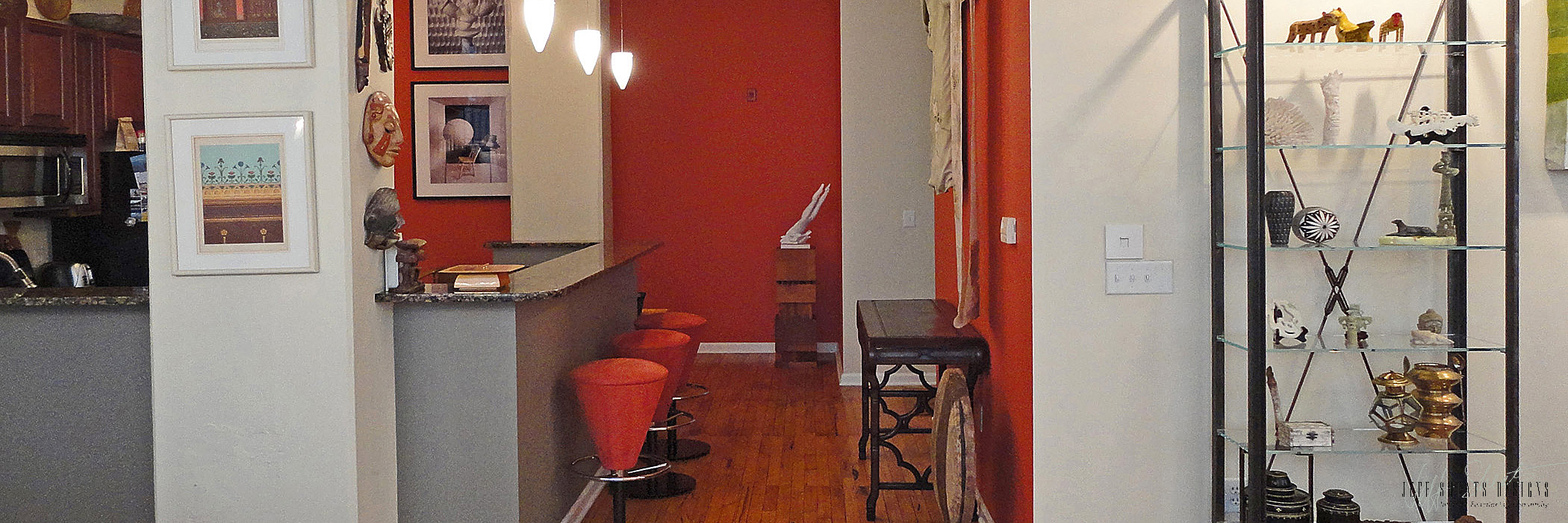Large Style for Small Spaces
Whether it is designing a small bathroom, a closet, a guest space, a vacation cottage or if you are now downsizing your primary home like many Americans these days, there are many excellent interior design tips to maximize your small spaces and create beautiful interiors in the process. While the cost of real estate and energy continue to impact many American’s lives, the need for proper design of lovely and functional smaller spaces is greater than ever.
Small spaces can be quiet desirable; a small space like a cozy den can envelop and comfort its occupants. A well designed small bathroom can be as functional and luxurious as a hotel spa bath. Less volume of space also means less maintenance, less hassle, less energy and less cost overall to operate. You do not have to live in a palace to reap the benefits and joy of stunning interior design in a small room.
Proper planning is always an important component of interior design, but it is particularly critical in designing for small spaces. I always start a new interior design client with a personal interview and an in-depth survey of their specific desires. I walk and photograph the spaces, then carefully field measure everything, paying attention to mechanicals and what is behind walls, floors and ceilings as well. Perhaps there is a bulkhead, attic space or closet that could be combined into a smaller space to enhance it.
A great way for a homeowner to create small spaces on their own would be to measure and draw the space on graph paper, while forming a separate list of the quarter’s necessities. Scrutinize the potential uses of the room, the furniture requirements, storage needed and personal interests and tastes. Create a budget based on the financial means at your disposal, future changes in your life and the amount of time you plan to spend in the space. Previewing all this information before you start designing for your smaller space makes all the difference in your success.
One real key to a smaller space is organization: A space that has a sense of control and order will feel better and function better for work and play. Clutter makes a room look smaller and quickly fills up an undersized space. Find ways to stash your clutter with baskets under coffee tables or tucked into storage benches, furniture and cabinetry.
Another must have in a small space is proper built-ins. Nothing provides the utility of additional space better than a well thought out and executed built-in. Built-ins can include recessed book cases, benches, niches, and cabinetry of all sorts to name a few. By creating well planned built-ins, you not only add value to your real estate but the floor space is not compromised and the room offers more functionality.
Some structural elements to consider include removing all or part of a wall, or adding interior windows in a wall. You can also successfully and cheaply remove doors to create more path and floor space and convert them to simple cased openings with lovely millwork. Pocket doors also work great for this purpose. Adding larger windows or skylights can also add to the sense of openness in a small space.
Expand the space and bring the outdoors in by drawing the visitor’s eyes to gorgeous windows and clean window treatments. Avoid heavy patterned fabrics and trims in a small space, but instead utilize simple under treatments to provide privacy and light control. Use top treatments that blend with the furnishings like long, split draw draperies on simple rods, hung high in the room to create a great sense of height.
Storage space is usually in high demand for smaller areas, and the absolute best design tip is to utilize properly designed closets. Modular closets systems can store upwards to three times that of a poorly designed closet. A well designed closet works from the floor line to the ceiling and can contain drawers, doors, hanging spaces, open adjustable shelving, safes, and can be retrofit with additional modular storage materials as your needs change over time. The more effectively the space in your closets is utilized, the better it contains your clutter, freeing up space in the rest of your home.
Ceilings are the most underused space in any room. Consider ceiling mouldings to call the eye up and create a larger sense of space. You can also create built-ins at the ceiling level to allow for more storage and display opportunities. Creating a sense of height even in a room with 8’ ceilings can add to the spaciousness of a small room.
Avoid single overhead lighting, like a chandelier, in small spaces as it has a tendency to draw the walls in. Instead, increase the number of your light sources, placing them near walls to reflect and wash the surfaces. To avoid glare common in a smaller space, conceal your sources of light creatively with lampshades, directed spotlights or up lighting and always utilize dimmers where possible.
Analyze the materials of both your furniture and decorations: metal, glass, polished wood and leather all reflect light improving the brightness of a room. High gloss finishes are very much in vogue today. Exploit mirrors for their ability to enhance the feeling of space and reflect light. Place a large mirror opposite a window to reflect the outdoors on the opposing wall or frame a mirror in a windowless room to give a sense of a mock window. An interesting piece of framed artwork can create the same effect.
When furnishing small spaces, you should keep most of the furniture appropriately compact. The size of the space should balance with the size of most of its belongings. But, do not be afraid of a few larger scale pieces to add drama to your room. When selecting furniture, consider maximizing the utility of the piece. Furniture should always work double duty in small spaces as in the case with a sleeper sofa, some pull out seating cubes under a console table, or a large armoire with additional storage. Space planning a small space will almost always reveal most furniture is best offset only slightly from the walls to maximize path spaces.
Some final décor considerations for smaller spaces: Focus on simplicity and neutral backdrops. Visual unity among decorations enables the room to maintain a sense of class, without becoming cluttered and closed in. The details, furnishings and decorations, should be simple and balance each other. One method of balance is to make the surfaces of the room consistent, except for accents.
Color and sheen can help achieve consistency in the space. High gloss paint is extremely durable and helps reflect light – consider it on the ceiling and for sure on all millwork. Keep colors neutral except for perhaps one deep colored wall or for the insets of bookcases to draw the eye away from the middle of the room and create more space visually. Your accent wall color can also be used as inspiration for toss pillows and throws, to create vibrancy and reflect your personal style in your small space to make it all your own.
Please feel free to contact us via telephone at (317) 357-0155 with any questions about this material or to request more information about our services. Visit the It’s YouTM section on our website at www.jeffsheatsdesigns.com to learn more about the Jeff Sheats Designs, Inc. interior design process. We are your partners in interior design.



